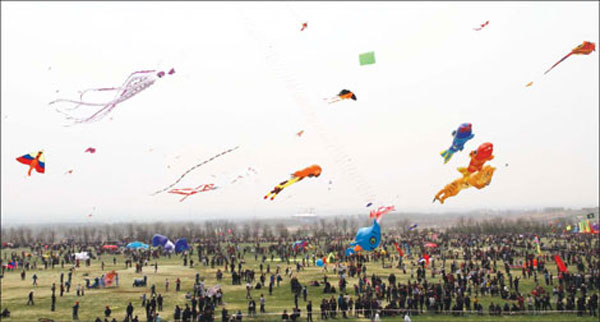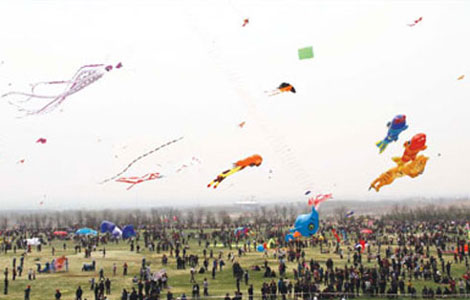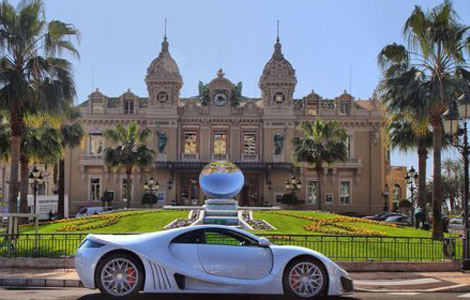Blowing in the wind
Updated: 2011-04-22 10:21
By Lin Jing (China Daily European Weekly)
 |
|
More than 100,000 people from 29 countries and regions attended the Weifang International Kite festival, one of the world's most famous kite flying events, from April 12 to 17. Wang Qian / China Daily |
High-Flyers from around the world recently traveled to home of the kite for a very special event
German kite enthusiast Andreas Fischbacher was in his element last weekend when he attended arguably the world's most famous kite festival. The 24-year-old journeyed to Shandong province, for the 28th Weifang International Kite Festival, joining thousands of kite fliers from China and all over the world to the homeland of the kite.
"I was into kites when I was 10," he grins. "My mother is a dress maker, showed me how to make and fly kites."
"I have been to many international competitions all over the world, including Vietnam and Malaysia, and Weifang was a great experience."
Kites do not have long history in Germany, he says, but is growing in popularity.
"There are around 80 kite associations and 10 festivals during a year. Some are international ones, which attract worldwide kite players," Fischbacher says. "In Germany, it is a sport for everyone, from children to senior citizens."
According to ancient Chinese texts, the kite was developed by the famous philosopher Mozi about 2,500 years ago and improved by a renowned carpenter Lu Ban in the 5th century BC.
At first, kites were used for military purposes and during the Southern Dynasty (AD 420-589), soldiers used kites to send rescue signals.
During the Tang Dynasty (AD 618-907), flying kites became a recreation. People tied bamboo instruments on kites and different musical tones would ring out in the air. Because the kites sounded like a koto instrument, people began to call them fengzheng, or "wind koto".
After the Tang Dynasty (AD 618-907), Chinese kites started to spread around the world and by the end of the 13th century, Italian traveler Marco Polo introduced stories of kites to Europe.
In China, flying kites is still a way to express best wishes and hopes for the future. Spring is the time for kite flying, and people attach pictures and words to their kites symbolizing their dreams of longevity and good luck.
In the West, kites were often used for other practical uses in science and meteorology. In 1750, Benjamin Franklin designed an experiment to prove that lightning is electricity by flying a kite into a lightning storm. In Britain, kites were used to test theories of aerodynamics and in the 1920s the British navy used kites to haul human lookouts into the sky for military observation.
After centuries of development, kite flying has become a popular sport in Europe.
"Kites are quite popular in France and all over the Europe," says Serge Allegre, a middle school teacher from Paris.
Allegre has been flying kites for 25 years and is also the founder and president of a kite association in Paris. He says people in Marseilles and Mediterranean area love the hobby with a passion.
"In France, there are four to five big kite festivals a year. In Dieppe, a city in Normandy, there is big festival held every two years, which would last for one week and receive around 1 million participants."
He says kites players in Europe prefer to make kites by themselves.
"Chinese kites are more traditional in forms, like swallows and fishes. In France, we make kites into stamps or the Eiffel Tower," he says.
Helmut C. Georgi, 59, a kite shop owner from Austria, says every year there are major kite festivals and exhibitions in Austria, where players come and show off their creations.
"At the annual Vienna Kite Festival, around 2,000 people will come and that is big number for Austria," he says.
Georgi has been flying kites since he was four and today travels around the world to attend different kite competitions and festivals.
He says flying kites certainly gives him a lift. "Flying kites makes me relax," he says. "Besides, in international festivals, we meet friends all over the world and share the same hobby."
Meanwhile back in China, traditional kite makers fear their tradition will be lost.
"It is difficult to find proper successors for traditional kite making and the number of kite craftsman is decreasing," says Han Fuling, 79, deputy director of Kite Arts Commission in Shandong Arts & Crafts Association and also an craftsman of traditional kites.
Han has been making kites for 72 years and his creations have won various prizes at many international competitions.
"To become a qualified kite craftsman, one has to master the skills of binding, pasting, drawing and flying and each element takes a long time to master," Han says. "Nowadays young people are not willing to learn."
At the same time, some forward-looking export-oriented kite companies are developing new products, such as the "power kite" in an effort to boost the industry. Power kites originated in the US and Europe in 1992 and can harness large wind forces, and are used in kite surfing, kite boarding, and kite skiing.
"We spent six years on research and development of a new power kite with 3D wind simulation technology," says Jie Bing, director of Albatross Stunt Kite Company in Shandong.
The company is the only power kite maker in Weifang and all of its products are exported to Europe. In the past two years, its revenue has been growing by about 20 percent annually.
Jie says compared to traditional kites, power kites have a better market potential in the Europe.
"A power kite is priced at 860 euros to 1,076 euros, with a gross margin more than 50 percent," he says. "Besides, power kites are easy to transport and has no specific requirements for weather or geographical conditions. It could be used for different sports activities," he says.
"Power kite sports are quite popular among middle class in the Europe. Many of them would pack up power kites and go for kite surfing in the weekend."
Jie says the world kite industry is developing at a fast pace but Chinese kites have fallen behind the US and Europe in terms of design and technology."
"From paper and bamboo to nylon and carbon fiber, from traditional kites with single line to power kites with two to four lines, the industry is experiencing a fast development," he says. "But lack of advanced technology and limited product types have hindered the development of Chinese kites."
He says R&D is of great importance for domestic kites companies and they should keep pace with latest industry trend in the world and develop new models frequently.
E-paper

Blowing in the wind
High-Flyers from around the world recently traveled to home of the kite for a very special event.
Image maker
Changing fortunes
Two motherlands
Specials

25 years after Chernobyl
Belarus, Ukraine and Russia will mark the 25th anniversary of the nuclear reactor explosion in Chernobyl.

Luxury car show
The world's most prestigious luxury, sports cars and supercars are displayed in Monaco.

Peking Opera revival
Traditional opera is enjoying a revival in Beijing thanks to some modern touches.
